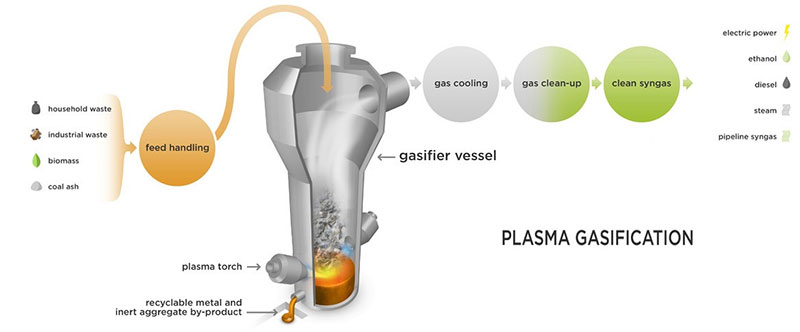Opposed to what happens in other systems used for waste disposal, since the dissociation of the products subjected to treatment takes place in the absence of oxygen, the application of plasma technology does not involve the emission of volatile substances such as combustion gases or harmful substances such as furans and dioxins.
With this process it is possible to treat - mixed or singularly - all solid and liquid waste of toxic-harmful nature. There is no need for a preventive selection of the waste but a Feasibility Study must be carried out beforehand for the system to be adopted to convey the products to be treated hermetically to the torch.
A system that uses this plasma technology is composed by a reactor including a plasma torch, the equipment required for its operation and the cleaning system for the fuel gas produced. This gas will be used for the combined production of electricity and thermal energy in cogeneration plants, or to produce chemicals including methanol.
The system is essentially constituted by a reactor to which the plasma torch is connected. In the upper part of the reactor occurs mainly the thermal transformation of the organic component of the waste generating a combustible gas: the syngas. In the lower part of the reactor there is both a thermal transformation and a kinetic transformation due to the plasma particles with energy higher than the thermal. The non-dissociated organic component, together with the inorganic component falls by gravity into the plasma area.
Here the organic part is completely dissociated generating other syngas, while the inorganic part is mixed in a molten bath possibly enriched with a fluidifier to improve its castability.
The molten slag is extracted from the bottom of the reactor while the gases produced exit from the top of the reactor: the formation of dioxins and furans and other toxic compounds resulting from the dissociation and molecular recombination is practically canceled and, in any case, if were to be present, they falls broadly within the limits of the law.
The heavy metals in the reactor and those from the felling sections of the syngas are inerted forming a vitrified material. Even the non-combusted fraction of the waste, after its removal from the reactor in molten form (slag), is cooled by solidifying into a material that can be used for useful purposes without environmental risks (road and / or railway ballast, objects, nourishment of sandy shores etc.).
In general, the extremely fast thermal reaction and the treatment at extremely high temperatures allow the total destruction of toxic organic compounds and the vitrification and encapsulation of inorganic compounds.











